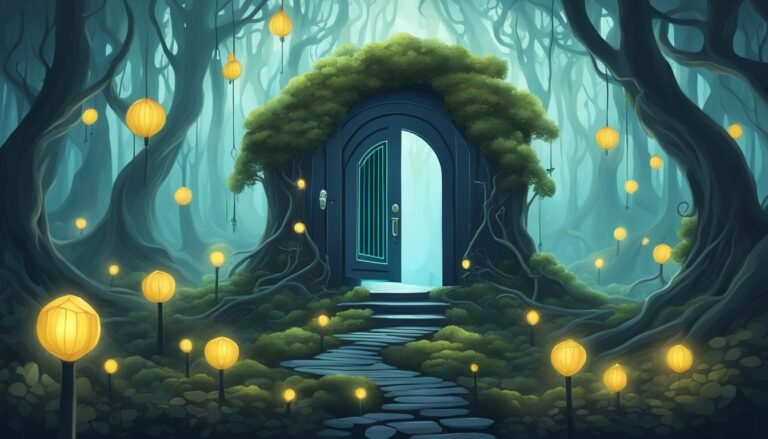Dream Symbolism in Literature: Unraveling Hidden Meanings

Dream symbolism in literature has always fascinated readers and writers alike. Dream symbols often play a central role in conveying hidden meanings and adding complexity to narratives. They invite you to engage your imagination and interpret the deeper messages behind the story.
From ancient myths to modern novels, dreams serve as a crucial tool for exploring profound themes and emotions.

Think about the way dreams in books like “Jane Eyre” by Charlotte Brontë highlight the character’s inner desires and fears.
In such stories, the dreams aren’t just random; they offer valuable insights into the character’s psyche and help you understand them better.
This technique adds layers to the narrative and keeps you intrigued, seeking out the underlying truths hidden within the dream sequences.
Exploring dream symbolism can make your reading experience richer and more rewarding.
Whether it’s a dream allegory from medieval literature or a modern tale using symbolic imagery, there’s always something new to discover.
If you’re looking for a deeper dive into the world of dreams and their meanings, consider checking out this resource: link.
Historical Evolution of Dream Symbolism

Dream symbolism has played a significant role throughout history.
From ancient myths to modern literature, dreams have been used to convey deeper meanings and insights.
Ancient Mythology and Dreams
In ancient Mesopotamia, dreams were seen as divine messages.
The Epic of Gilgamesh shows this clearly with Gilgamesh’s dreams predicting future events.
He dreams of an axe falling from the sky, symbolizing the arrival of his friend, Enkidu.
Ancient Egyptians also placed great importance on dreams.
They had dream books that interpreted common dream symbols, guiding their actions and decisions.
Greek mythology, too, is filled with prophetic dreams.
For example, in The Iliad, Zeus sends dream messages to alter the course of events.
Medieval and Renaissance Literature
During the medieval period, dreams were often viewed through a religious lens.
Early Christian texts used dreams to promote spiritual authority and justify actions.
Visionary literature, like The Divine Comedy by Dante, used dreams to explore themes of morality and redemption.
In the Renaissance, dream symbolism became more complex.
Shakespeare’s plays, such as A Midsummer Night’s Dream, used dreams to explore human desires and conflicts.
This era blended mystical elements with human psychology, deepening the symbolic nature of dreams.
Freudian Influence on Modern Literature
Sigmund Freud’s The Interpretation of Dreams revolutionized how we view dreams.
Freud saw dreams as windows into the unconscious, filled with symbolic content related to our innermost desires and fears.
This idea had a huge impact on modern literature.
Writers started using dream symbolism to explore character psyches and narrative complexities.
For example, James Joyce’s Ulysses and Franz Kafka’s The Trial use dream-like sequences to blur reality and imagination, reflecting deeper truths and anxieties.
Freud’s influence is still seen in contemporary works that delve into the subconscious mind through dreams.
Feel free to explore more about history and dream interpretations by visiting this Dream Interpretation Resource.
Major Themes in Dream Symbolism

Dream symbolism in literature usually explores deep aspects of the human psyche.
Here are some specific themes that regularly appear in dream symbolism: the subconscious mind, foresight and prophecy, inner desires and fears, and the idea of escaping from reality.
The Subconscious Mind
Dreams often tap into the subconscious mind, revealing hidden thoughts and feelings.
Writers use this theme to show characters’ true selves, away from their conscious behaviors.
For instance, in Shakespeare’s A Midsummer Night’s Dream, the moon symbolizes the subconscious, influencing the characters in mystical ways.
When you dream, your mind can reveal thoughts and desires you might not be aware of during waking hours.
Through literature, you can explore this hidden part of human nature deeply.
Foresight and Prophecy
Dreams have been used as tools for foresight and prophecy in literature.
They often predict future events or reveal hidden truths.
For example, in many classical stories, characters receive important messages through dreams.
This theme is powerful because it adds a sense of mystery and anticipation.
Authors might use dreams to foreshadow upcoming events in the plot, making readers eager to see how these dreams come to reality.
Inner Desires and Fears
Another major theme in dream symbolism involves inner desires and fears.
Dreams can highlight what characters truly want or fear.
In Langston Hughes’ poem “Dreams,” broken dreams symbolize lost aspirations and disappointments.
These dreams can show what drives characters or what holds them back.
By examining these symbolic dreams, you gain insight into the deepest parts of characters’ souls, seeing their motivations and anxieties.
Escape from Reality
Dreams often serve as an escape from reality.
Characters may find solace in dreams, escaping from their troubled lives.
This theme resonates in stories where reality is harsh or unsatisfactory.
Through dreams, literature can create a contrast between the harshness of real life and the idealistic nature of dreams.
This can be comforting or painfully ironic, depending on how the dreams compare to the characters’ actual situations.
Explore more about how dreams offer an escape by checking this link.
Using these themes, you can better understand how dream symbolism adds layers of meaning to stories, enriching your reading experience.
Characteristics of Dream Sequences

Dream sequences in literature are full of vivid imagery, unique structures, and meaningful symbols that add layers of depth to the story.
They often reveal characters’ inner thoughts, foreshadow events, and contribute to the overall narrative.
Imagery and Metaphors
Dreams speak in pictures and symbols rather than words.
When writing a dream sequence, it’s important to use vivid imagery and strong metaphors.
These elements help bring the dream to life and convey the emotions and ideas that the character might not express openly.
For example, a character feeling overwhelmed might dream of a rising flood.
This captures their emotional state without needing to say it outright. Sensory details like sights, sounds, and even smells can also enhance the dream’s realism and impact.
Narrative Structure of Dreams
Dreams don’t follow the same rules as the waking world.
They can be disjointed, nonlinear, and even contradictory.
This unique structure allows for a more creative and flexible form of storytelling within your narrative.
You might start a dream in one place and suddenly jump to another.
Scenes can blend together in unexpected ways.
Characters can shift identities or roles, reflecting the dreamer’s subconscious mind at work.
This unpredictability can make dreams a powerful tool for revealing deeper truths about your characters or plot.
Symbolic Motifs
Dream sequences often use recurring symbols or motifs to underscore larger themes or ideas.
These symbols can be personal to the character or universally recognized, helping to tie the dream to the broader narrative.
Common symbols include falling, flying, or losing teeth, each carrying its own set of implications.
Pay close attention to the symbols you choose, as they should resonate with the character’s journey and the story’s themes.
By carefully selecting symbolic motifs, you can add layers of meaning and foreshadow future events.
If you’re interested in a deeper exploration of dream symbolism and how to apply it in your writing, you might find this resource helpful.
Influence of Dreams on Plot Development

Dreams can shape a story’s direction, reveal secrets, and create conflict.
They help develop characters and can foreshadow future events.
Dreams as Foreshadowing
Dreams often hint at what’s to come in a story.
These hints, or foreshadowing, help you predict future events.
Authors use this technique to build suspense.
For example, a character’s dream about a storm might mean trouble ahead.
When you read such dreams carefully, you can pick up clues about the plot.
These subtle hints keep you engaged and curious about what will happen next.
Character Development through Dreams
Using dreams in stories helps you understand characters better.
In dreams, characters might reveal their deepest fears, desires, or secrets.
These dreams show parts of the character that they might hide when awake.
For instance, a brave character might dream of feeling scared or weak, showing their vulnerable side.
Through these dreams, you get a deeper look into the character’s mind and emotions.
Dream-Induced Conflict
Dreams can also create conflict in stories.
Sometimes, a dream can make characters doubt themselves or others.
For instance, a character might dream of betrayal by a close friend and wake up feeling mistrustful.
This can lead to arguments and changing relationships.
These conflicts driven by dreams add layers to the plot and keep it interesting.
They show how something as simple as a dream can have big effects on the storyline.
💡 Enhance your reading experience with resources on dream analysis and interpretation. Click here to discover more about the power of dreams in literature.
Dream Symbolism in Various Genres

Dream symbolism is used across many genres to add depth to stories, uncover characters’ hidden desires, and enhance the theme.
Below, we discuss how dreams uniquely appear in fantasy, gothic literature, and science fiction.
Fantasy and Magical Realism
In fantasy and magical realism, dreams often bridge the gap between reality and the fantastical. Authors like J.K. Rowling use dreams to unveil important plot points or character secrets.
In Harry Potter, Harry’s dreams sometimes provide glimpses into Voldemort’s mind.
Another example is Gabriel Garcia Marquez’s One Hundred Years of Solitude, where dreams blend with reality, reflecting the characters’ subconscious and foretelling future events, merging the magical with the mundane.
These dreams make readers question what is real, adding richness to the narrative.
Gothic and Horror Literature
In gothic and horror literature, dreams serve to heighten fear and build suspense. Edgar Allan Poe’s works often feature dark, symbolic dreams that reveal deep psychological fears.
In The Fall of the House of Usher, Roderick Usher’s dreams foreshadow the house’s collapse and family doom.
Another example is Mary Shelley’s Frankenstein, where Victor Frankenstein’s terrifying dreams symbolize his guilt and foreshadow the tragic events caused by his experiments.
These nightmarish visions contribute to the eerie, unsettling atmosphere, making readers feel the characters’ dread.
Science Fiction and Utopian Works
In science fiction and utopian literature, dreams can explore alternate realities and futuristic visions. Philip K. Dick’s Do Androids Dream of Electric Sheep? questions the nature of reality and humanity through its protagonists’ dream experiences.
In George Orwell’s 1984, Winston’s dreams of the Golden Country represent his hope for freedom and rebellion against the oppressive regime.
Such dreams highlight the contrast between the characters’ desires and their harsh reality, emphasizing key themes of resistance and human spirit.
For a deeper dive into dream symbolism in literature, check out this link.
Interpretations and Critiques

Dream symbolism in literature can be seen through various lenses, each offering unique insights.
These include Psychoanalytic Literary Criticism, Structuralist and Semiotic Approaches, and Reader-Response and Reception.
Psychoanalytic Literary Criticism
Psychoanalytic criticism looks at how dreams in literature reflect the unconscious mind.
Sigmund Freud’s theories are heavily relied upon, especially his book The Interpretation of Dreams.
Freud believed that dreams are a way to uncover hidden desires and fears.
Authors like Franz Kafka and Edgar Allan Poe often used dream symbolism to explore deep psychological themes.
Complex symbols in these works can reveal much about the characters’ inner worlds and sometimes even the authors’ subconscious.
This approach helps you understand the hidden layers and personal struggles shown in literary dreams.
Structuralist and Semiotic Approaches
Structuralists and semioticians focus on how dream symbols function within the structure of a text.
They view literature like a language system, made up of signs and symbols.
Ferdinand de Saussure and Roland Barthes are key figures here.
Dream symbols aren’t just tied to personal psychology but are seen as part of a larger system of meanings.
For example, a recurring symbol like water might signify various ideas like change or purification, depending on the cultural context.
By focusing on these structures, you can see patterns and deeper meanings that aren’t immediately obvious.
Reader-Response and Reception
Reader-response theory highlights how readers interpret dream symbols based on their personal experiences and feelings.
This approach underscores that the meaning of a dream in literature isn’t fixed.
Instead, it changes with each reader’s individual perspective.
For instance, a symbol like a snake might be seen as evil by one reader but as a symbol of transformation by another.
It allows for a more diverse and dynamic understanding of literature.
By considering your own reactions and emotions, you can uncover personalized insights into dream symbolism.
For more on dream interpretations and symbolism, check out this resource.
Comparison of Dream Symbolism Across Cultures

Dream symbolism can vary greatly across different cultures.
While some symbols are universal, the interpretation and significance of these symbols often differ depending on cultural perspectives and traditions.
Eastern vs. Western Perspectives
In Eastern cultures, dreams are often seen as messages from the spiritual realm or ancestors.
For example, in Chinese culture, dreaming of teeth falling out might symbolize the death of a family member. Symbols like dragons and lotuses can appear frequently, each holding specific cultural importance.
Western cultures approach dreams with a mix of psychological and spiritual interpretations.
In many Western interpretations, teeth falling out in a dream might be linked to stress or anxiety rather than a literal event. Symbols like snakes often appear and are sometimes linked to transformation or hidden fears, influenced by Freudian concepts.
Indigenous Narratives
Indigenous cultures around the world have rich traditions for interpreting dreams.
For instance, certain Native American tribes view dreams as visions or prophecies meant to guide individuals or the community.
Animals like the eagle or bear often appear in these dreams, symbolizing strength, wisdom, or guardianship.
In Aboriginal Australian culture, the concept of Dreamtime places dreams at the core of understanding existence and the universe.
They believe ancestral beings shaped the world during Dreamtime, and dreams today connect individuals to these ancestral spirits and the land.
Cross-Cultural Analyses
Comparing symbols across cultures reveals some interesting commonalities and differences.
For example, water frequently appears in dream symbolism around the world.
In some African cultures, dreaming of water might represent life and fertility, whereas in Western contexts, it could relate to emotions and the subconscious.
Dreaming of a journey can be another crossover symbol.
In Hindu traditions, a journey might symbolize a spiritual path or life progression, while in Western traditions, it might represent personal growth or a need for change.
For a deeper insight into understanding dream cultures, consider exploring additional resources here.
These resources can expand your knowledge on how different cultures interpret their dreams.
Dream Symbolism in Contemporary Literature

Dream symbolism in contemporary literature often reflects modern and postmodern perspectives on reality.
Various literary movements and technological advances shape how dreams are portrayed and interpreted in today’s works.
Modernist Approaches to Dream Realities
Modernist writers view dreams as an integral part of their characters’ inner lives, often using dreams to reveal hidden desires or fears.
They focus on the dream’s fragmented nature, mimicking the chaotic inner thoughts of individuals.
Authors like Virginia Woolf and James Joyce use stream-of-consciousness techniques to illustrate how dream and reality intermingle.
Their characters’ dreams are filled with symbolic imagery that sheds light on their psychological states.
The goal is to provide deep insights into the characters’ minds by presenting dreams as fluid and often disjointed experiences.
Postmodernist Deconstructions of Dreams
In the postmodernist approach, dreams are often deconstructed to explore themes of reality and illusion.
These authors question the nature of dreams and their significance, often blurring the lines between dream and reality.
Writers like Thomas Pynchon and Don DeLillo use dreams to highlight the uncertainties and complexities of the modern world.
Their narratives often feature characters who cannot distinguish between their waking life and their dreams, creating a sense of ambiguity and confusion.
This serves to critique the established norms and challenges readers to question their perceptions of reality.
The Influence of Technology on Dream Narratives
Technology has dramatically influenced contemporary dream narratives.
With the rise of digital media, the portrayal of dreams in literature has evolved to incorporate elements of virtual reality and cyberspace.
Authors are now exploring how digital environments affect our subconscious.
Books like “Neuromancer” by William Gibson examine how technology shapes our dreams and what it means for our understanding of self.
Tech-driven dream sequences often focus on the intersection of human consciousness and artificial intelligence, creating a new dimension for dream symbolism in literature.
For those interested in a deeper look at how modern literature tackles dreams and technology, check out this link.
By focusing on these specific approaches, you get a comprehensive view of how contemporary literature uses dream symbolism to explore complex themes and reflect the evolving human experience.






